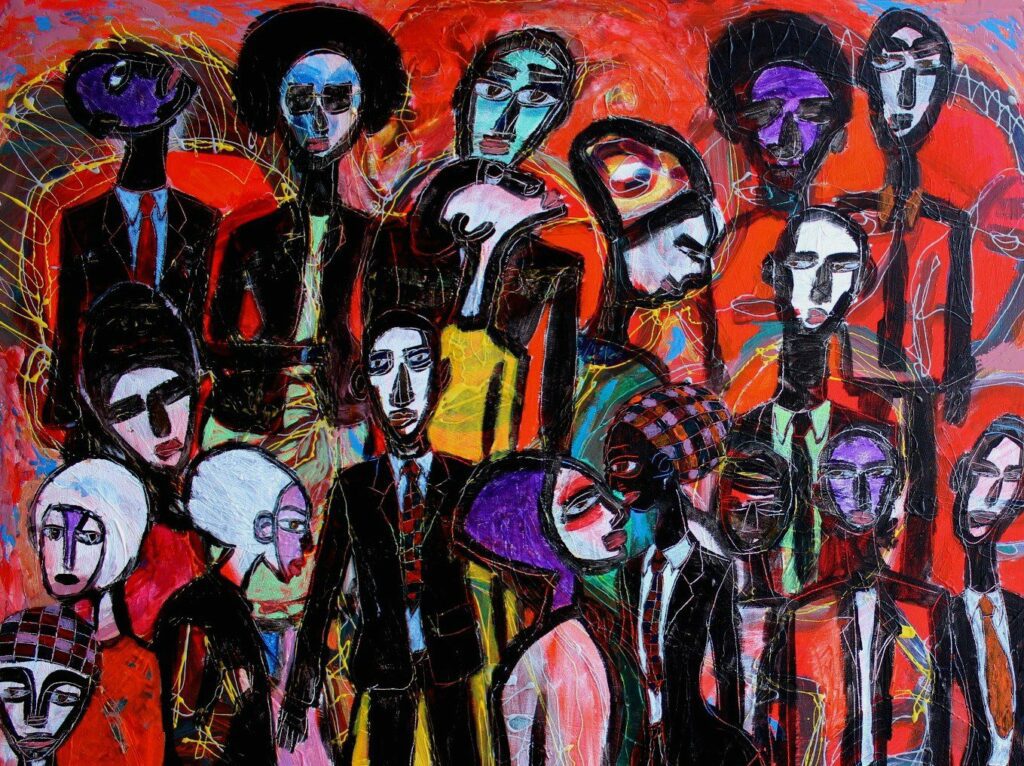Afriart Gallery, Kampala, Uganda
04 Sep 2015 - 30 Sep 2015

Eria Solomon Nsubuga, Black face, White Masks, 90 x 90cm, mixed media, 2015
On September 4th, Afriart Gallery center for contemporary art in Uganda opens ‘Black face, white masks’, an exhibition with brand new work of Eria Solomon Nsubuga also known as ‘SANE’, born 1979.
SANE is a contemporary Ugandan painter, illustrator, sculptor and art lecturer. An active practicing artist since 1999, he has had several successful solo and group shows in Kampala, Nairobi, Dar-es-Salaam and beyond. His work is enjoyed on virtually all continents of the world. He is a social artist choosing to study the climate of politics, allocation of resources, morality and spirituality. Some writers and scholars refer to him as a political artist.
SANE’s recent work delves into the murky world of the politics of aggressive racialism (racism), and addresses ‘Africanity’ against the backdrop of post-nationalism.
The title of the show is drawn directly from the first book of Martiniquais critical theorist Frantz Fanon (Black Skins, White Masks, 1952) which looks at negritude (originality) and whiteness (the imposed mask) as signifiers of a wider colonial construct. In an increasingly marginalized and polarized geo-political global setting, encryptions of Inferiority (colonized people) and superiority (colonizers) are inevitable tools for empires of capital, neo-liberalism and so on.
“Every colonized people– in other words every colonized people in whose soul an inferiority complex has been created by the death and burial of its cultural originality—finds itself face to face with the language of the civilizing nation; that is, with the culture of the mother language.” Fanon, Black Skins, White Masks (1952)
SANE also addresses coloniality and the politics of black aesthetics where he questions the Western definitions of beauty and the conflicts that globalism presents to beauty in the black context. The Western aesthetic presents our blackness as being too black, and it must therefore be whitened in order for us (blacks) to gain acceptability in the post industrial age. ‘Commands’ like these from the mass and printed media of ‘mother countries’ are making black women bleach their skins to whiten them and causing them to wear synthetic blonde and red hair pieces, in the process gaining new market opportunities for Western beauty products whilst at the same time furthering the loss of ‘cultural authenticity’ on the continent.
“The colonized is elevated above his jungle status in proportion to his adoption of the mother country’s cultural standards. He becomes whiter as he renounces his blackness, his jungle.” Fanon, Black Skins, White Masks (1952)
In light of this aggressive ‘disafricanisation’, SANE is aware of the calls from outside to re-de-colonise art spaces in Uganda and the need to seek an embrace with our tribal indigenous identities as forms of push back against colonial agencies. Furthermore there are attempts being made to recapture indigenousness in terms of languages and trials to make them parts of the circuits of communication in academic and intellectual fields including the visual arts. This however appears to be the second wave of decolonization after the aggressive re-colonization that Africa has suffered in the last quarter of the 20th century and into the 21st century due to global ‘market forces’ that have brought in huge waves of Americanized Westernisation, Coca Cola, Walmart, and the supermarkets. It would seem that corporate business empires are the new forms of global hegemony replacing governments.
All the above notwithstanding, SANE’s work invites us to remember that blackness is no longer simply an identity issue of continental Africanness, and neither is whiteness an issue of Europeanness or Americanity. Just as blackness is now part of the Euro-American cultural equation, we must accept that whiteness is also very much part of the African cultural context too. What then happens to the idea of ‘cultural originality’ in the face of the global hybridization of culture brought about by human movement and settlement, re-movement and re-settlement? Culture however is not static and originality cannot be looked at only in terms of ‘how things used to be’. Contact with the colonizers for us the colonized has created cultural hybridization which also is to be looked at as authentic. We are black faces, white masks and white faces, black masks! Black masculinity is becoming more feminized and we also will have to deal with the automation of emotionality brought about by interaction with Western made technological products and machines according to Cameroonian philosopher Achille Mbembe.
Opening: September 4th, 06:00 PM